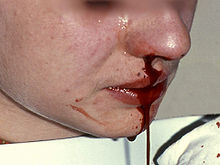Epistaxis
| Classification according to ICD-10 | |
|---|---|
| R04.0 | Epistaxis |
| ICD-10 online (WHO version 2019) | |
With a nosebleed (technical term epistaxis ἐπί ‚above ' σταζω ‚ drip') blood comes out of the nose. In most cases it is not dangerous, but in individual cases it can be difficult to control or it can be life-threatening. Dangerous bleeding usually originates from the back of the nose ( arteria sphenopalatina ). In more than 80% of cases, however, the nosebleed is simply caused by local vascular injuries to the anterior nasal septum.
causes
The causes of nosebleeds are different. One differentiates nosebleeds by local causes from nosebleeds as a symptom of a general illness.
- locally caused nosebleed
- so called idiopathic or constitutional nosebleeds; occurs repeatedly, especially in children on
- physical, chemical or inflammatory damage to the nasal mucous membrane (e.g. vascular damage in the area of the Kiesselbachi locus at the transition from the nasal vestibule to the nasal cavity, e.g. from nasal drilling , drug abuse, iatrogenic or inflammatory perforation of the nasal septum, foreign nasal bodies, rhinolite )
- Trauma (e.g., fracture of the base of the skull, fracture of the nasal bones or nasal septum )
- benign and malignant tumors of the nose, nasopharynx and paranasal sinuses
- Formation of spurs and / or ridges
- Allergy, acute rhinitis , dehydration of the nasal mucous membranes (e.g. from air conditioning)
- Epistaxis as a symptom of a general illness
- acute infectious diseases (e.g. virus flu , typhus , measles )
- Vascular and circulatory diseases (e.g. arteriosclerosis , arterial hypertension , Osler-Rendu-Weber disease , Henoch-Schönlein purpura , granulomatosis with polyangiitis , diabetes mellitus , arteriovenous malformation )
- hemorrhagic diathesis (e.g. hemophilia A and B, vitamin K deficiency , hepatocellular insufficiency, anticoagulants )
- Thrombocytopathy (e.g. Willebrand-Jürgens syndrome , uremia , dysproteinemia , adverse drug side effects of dextran and acetylsalicylic acid )
- Thrombocytopenia , for example idiopathic thrombocytopic purpura , proliferation disorder or distribution disorder of the platelets
- Lack of vitamin C ( scurvy )
- hormonal changes or diseases, for example pheochromocytoma , diabetes mellitus
Symptoms
A nosebleed can be recognized by the blood leaking from the nose. In most cases it is dark red, but it can also be bright red spurting ( arterial bleeding). Occasionally, however, a nosebleed can be simulated if, in the case of heavy bleeding in another location (e.g. bleeding from esophageal varices ), blood escapes through the nose.
hazards
With arterial nosebleeds, there is a risk of bleeding to death ( hypovolemic shock ). If the person is unconscious, there is a risk of aspiration of blood, i.e. inhalation of blood into the windpipe . Swallowing autologous blood is not dangerous, but it often leads to vomiting because blood acts as a powerful emetic .
diagnosis
The diagnosis of nosebleed includes measuring blood pressure. In the case of heavy bleeding, the hemoglobin value , the platelet count , the bleeding time and the thromboplastin time , the partial thromboplastin time PTT and the thrombin time TZ should be determined by taking a blood sample, whereby the blood loss can be quantified and a disturbance of the blood clotting can be excluded. To determine the location of the bleeding, the nasal mucosa can be inspected using anterior rhinoscopy or endoscopy after local anesthesia and decongestion .
Immediate action
Especially in children with nosebleeds, it is important to have a calming effect on the patient. The seated patient bends his head forward so that the blood can flow forward out of the nose. If the head is bent back, the blood is swallowed and the extent of the bleeding cannot be assessed; if the consciousness is impaired, there is a risk of blood aspiration and obstruction of the airways. The nostrils can then be compressed for a few minutes, which should stop uncomplicated nosebleeds from the anterior nasal sections, especially frequent bleeding from the Kiesselbachi locus on the nasal septum . Arterial bleeding from the back of the nose is not affected by the compression of the nostrils; the blood then escapes through the mouth undiminished. Furthermore, wet, cold compresses on the neck can help fight nosebleeds.
If these measures do not lead to any improvement or if threatening symptoms occur (large blood loss, prolonged nosebleeds, impaired consciousness of the patient), immediate treatment in a specialist department of a hospital is required. Immediate medical measures are particularly necessary in the case of known blood clotting disorders, i.e. disorders in hemostasis .
Further therapy
In ENT -Fachärzten or in hospital with ENT department of further options hemostasis are available. These include etching with silver nitrate in the case of minor nosebleeds from the Kiesselbachi locus, anterior or posterior nasal packing ( Bellocq tamponade ), electro / laser coagulation , vascular ligature ( anterior and posterior ethmoid arteries , maxillary arteries ) or interventional angiographic embolization . A tried and tested method in the case of previous illnesses from Osler's disease is the use of an Nd: YAG laser to sclerose prominent blood vessels in the area of the Kiesselbachi locus.
Furthermore, if necessary, systemic or local causes of the nosebleed are treated in order to prevent recurrence.
literature
- Rudolf Probst, Gerhard Grevers, Heinrich Iro: Ear, nose and throat medicine . Georg Thieme Verlag, Stuttgart 2000, ISBN 3-13-119031-0 , pp. 32-35.
Web links
Individual evidence
- ↑ Sönke Müller: Memorix emergency medicine.
- ^ Wikibooks, First Aid Epistaxis
- ↑ a b c Jürgen Durst: Traumatologische Praxis . Standards in diagnostics and therapy for all disciplines. Schattauer Verlag, Stuttgart 1997, ISBN 3-7945-1587-0 , p. 245 .
